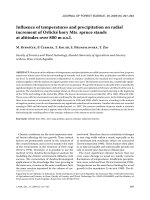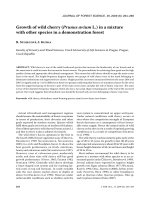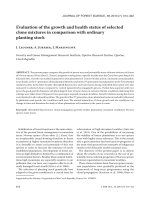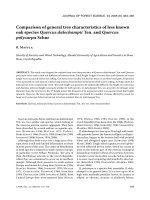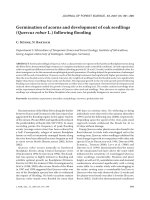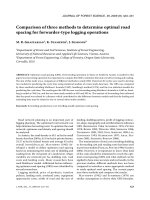Báo cáo lâm nghiệp: "Comparison of nitrogenase and nitrate reductase activities in two nitrogen-fixing tree species: black alder (Alnus glutinosa) and black locust (Robinia pseudoacacia)" pdf
Bạn đang xem bản rút gọn của tài liệu. Xem và tải ngay bản đầy đủ của tài liệu tại đây (209.97 KB, 5 trang )
Comparison
of
nitrogenase
and
nitrate
reductase
activities
in
two
nitrogen-fixing
tree
species:
black
alder
(Alnus
glutinosa)
and
black
locust
(Robinia
pseudoacacia)
G.
Pizelle
1
S.
Benamar
1
F.
Boutekrabt
1
G.
Thiéry
2
I
Laboratoire
de
Physiologie
Végétale
et
Forestibre,
Facult6
c/es
Sciences,
BP
239,
54506
Vandœuvre-Iès-Nancy
Cedex,
and
2
Physiologie
V6g6tale,
ENSAIA,
54500
!anda°wre-/e5-/B/ancy.
France
Introduction
Among
the
symbiotic
nitrogen-fixing
trees
of
the
temperate
zone,
black
alder
(Alnus
glutinosa,
L.
Gaertn.)
and
black
locust
(Robinia
pseudoacacia
L.)
can
be
re-
garded
as
typical
actinorhizal
(frankial)
and
leguminous
(rhizobial)
woody
species,
respectively.
Important
differences
be-
tween
both
species
concern
their
biologi-
cal,
ecological
and
symbiotic
characteris-
tics,
and
the
greater
amount
of
work
recently
devoted
to
A.
glutinosa,
which
likely
prevails
over
R.
pseudoacacia
on
the
following
grounds:
ubiquity
in
Europe,
better
sylvicultural
qualities,
absence
of
spines
and
suckers,
easier
collection
of
the
nitrogen-fixing
organs,
attraction
to
the
more
recently
recognized
actinorhizal
symbiosis
(Tjepkema
et al.,
1986).
Never-
theless,
R.
pseudoacacia
is
also
a
tree
of
interest
both
for
its
role
as
symbiont
in
nitrogen
fixation
and
for
its
potential
value
as
timber
and
wood
fiber
source
(Moiroud
and
Capellano,
1982;
Turvey
and
Smeth-
urst,
1983);
hence,
our
desire
to
progress
in
understanding
of
its
physiology.
In
an
extension
of
our
work
on
nitrogen
nutrition
of
A.
glutinosa
(e.g.,
Pizelle
and
Thiéry,
1986),
the
present
paper
examines
the
nitrogenase
and
nitrate
reductase
ac-
tivities,
measured
in
vivo,
in
R.
pseudoa-
cacia
and
compares
them
with
the
data
from
A.
glutino!;a.
Materials
and
IMethods
Plant
material
was
harvested
in
the
early
afternoon
from
1!
3-20
yr
old
black
alders
natu-
rally
growing
on
sandy
alluvium
and
from
black
locusts
planted
for
about
10
yr
on
a
sandy
and
stony
bank;
both
sites
were
located
on
a
sili-
ceous
substrate
in
the
Moselle
valley
near
Nancy.
Nitrogenase
(t’BI2ase)
activity
was
assayed
by
the
C2H2
reduction
method
on
excised
actino-
rhizal
lobes
of
alder
and
on
excised
nodules
of
black
locust.
Nitrate
reductase
(NR)
activities
were
assayed
on
5
mm
sections
of
small
roots
(diameter
1
1 mrr!;
100
mg
fresh
tissue)
and
on
disks
of
young
fully
expanded
leaves
(diameter:
12
mm;
2
disks).
The
root
samples
were
vacuum
infiltrated
in
2.5
ml
of
0.1
M
NaK
phos-
phate
buffer,
pH
7.5,
with
or
without
0.05
M
KN0
3.
After
incubation
for
1
h
at
30°C
in
the
dark,
1.5
ml
of
incubation
medium
were
cleared
by
addition
of
0.3
ml
of
1
M
Zn
acetate
and
cen-
trifugation.
In
the
leaf
NR
assays,
Triton
X-100
was
added
(0.1%,
v/v)
to
the
incubation
medium
and
clearance
of
Zn
acetate
was
not
necessary.
The
nitrite
concentrations
of
the
NR
incubation
media
and
soil
nitrate
content
were
determined
as
described
by
Pizelle
and
Thi6ry
(1986).
Results
N2
ase
activity
In
A.
glutinosa
the
enzyme
activity
started
earlier
in
spring
and
disappeared
later
in
autumn
than
in
R.
pseudoacacia.
During
the
growing
season,
N2
ase
activity
of
the
nodules
of
R.
pseudoacacia
reached
higher
values
than
that
of
the
actinorhizas
of
A.
glutinosa
(Fig.
1
This
difference
might
be
explained
by
the
following
char-
acteristics:
most
nodules
of
black
locust
were
less
than
1
yr
old
with
a
large
vol-
ume
of
inner
tissues
invaded
by
the
active
bacteroids,
whereas
the
alder
actinorhizas
included
lobes
of
various
ages
(often
more
than
1
yr
old)
with
the
tissues
containing
the
active
vesicles
of
Frankia
limited
to
the
subapical
cortical
region.
NR
activity
of
the
small
roots
Root
NR
activity
of
both
species
did
not
disappear
in
winter
(Fig.
2).
The
enzyme
activity
and
the
soil
nitrate
content
of
the
relevant
site
showed
higher
values
in
A.
glutinosa
than
in
R.
pseudoacacia.
In
contrast
with
the
alder
roots,
the
roots
of
hI
black
locust
likely
accumulated
nitrate,
since
the
NR
activities
measured
with
and
without
KN0
3
in
the
incubation
medium
were
similar.
.
.1
30
At
the
A.
glutinosa
site,
higher
values
of
soil
nitrate
content
and
of
enzyme
activity
were
measured
during
the
growing
sea-
son,
but
no
significant
correlation
(r=
=
0.25;
n = 21 )
was
found
between
these
parameters.
NR
activity
of
the
leaves
Previous
experiments
showed
that
the
leaf
NR
activity
of
field-grown
A.
glutinosa
was
high
after
bud
opening
in
the
spring,
then
decreased
during
the
growing
season,
before
disappearing
at
the
leaf
fall;
the
presence
of
this
NR
activity
was
found
to
be
independent
of
the
supply
of
nitrate
to
the
leaves
via
the
xylem
sap
(Pizelle
and
Thi6ry,
1977
;
1986
).
From
the
present
data
(Table
I),
it
appears
that
field-grown
R.
pseudoacacia
also
had
a
notable
leaf
NR
activity;
the
values
were
lower
in
spring
than
in
sum-
mer,
unlike
the
pattern
observed
in
A.
glu-
tinosa.
It
is
presently
unknown
whether
the
variations
of
the
leaf
enzyme
activity
were
controlled
by
the
nitrate
supply
under
field
conditions.
However,
assays
using
young
nodulated
black
locusts
grown
on
nutrient
solution
without
nitrate
showed
an
increase
of
their
leaf
NR
activity
from
0.78
±
0.16
to
3.23
±
1.15
nmol
N02 !mg-!
DW-h-
1
(means
of
4
samples ±
SE)
after
3
days
of
4
mM
NaNO
3
supply.
Discussion
and
Conclusion
Though
the
age
of
the
trees
and
the
na-
ture
or
nitrate
content
of
the
soil
differed
between
the
respective
sites
of
each
spe-
cies,
the
present
data
reveal
some
char-
acteristics of
the
in
vivo
N2
ase
and
NR
activities
in
field-grown
A.
glutinosa
and
R.
pseudoacacia.
N2
ase
activity
of
the
actinorhizas
of
A.
glutinosa
lasted
longer
but
reached
lower
values
than
that
of
the
nodules
of R.
pseudoacacia
during
the
growing
season.
These
differences
are
probably
related
to
the
length
of
the
period
of
active
photo-
synthesis
and
to
the
anatomical
structure
of
the
nitrogen-fixing
organs
in
each
spe-
cies.
Since
N2
ase
activity
is
measured
per
mg
dry
weight
of
actinorhiza
or
nodule,
further
data,
such
as
the
mass
of
symbio-
tic
organs
per
tree,
would
be
necessary
to
compare
the
nitrogen-fixing
potential
of
the
trees
of
both
species.
The
presence
of
a
root
NR
activity
in
winter
indicates
the
persistence
of
the
enzyme
and
reducing
power
in
the
roots
out
of
the
growing
season.
Since
nitrate
was
found
in
the
soil,
even
in
winter,
it
might
suffice
to
maintain
a
nitrate-indu-
cible
NR
activity
in
the
roots
throughout
the
year.
The
presence
of
non-reduced
nitrate
in
the
roots
of
R.
pseudoacacia,
in
spite
of
a
low
nitrate
content
in
the
soil,
indicates
a
limited
root
NR
activity
in
this
species.
In
A.
glutinosa,
the
negligible
accumulation
of
nitrate
in
the
roots
and
the
absence
of
a
close
correlation
bet-
ween
root
NR
activity
and
soil
nitrate
content
suggest
that
the
roots
have
an
NR
capacity
able
to
reduce
higher
amounts
of
nitrate
than
those
available
in
the
soil.
The
seasonal
profile
of
the
leaf
NR
ac-
tivity
of
A.
glutinosa
appears
to
be
inde-
pendent
of
the
nitrate
supply;
it
decreases
from
the
early
leaf
expansion
to
the
approach
of
the
leaf
fall.
In
R.
pseudoa-
cacia
the
leaf
NR
activity
shows
a
different
profile
with
values
lower
in
spring
and
higher
in
summer.
Given
the
results
ob-
tained
from
young
laboratory-grown
plants
as
well
as
the
presence
of
a
limited
ni-
trate-reducing
capacity
of
the
roots,
it
can
be
proposed
that
the
leaves
of
R.
pseu-
doacacia
have
an
NR
activity
commensu-
rate
with
their
supply
of
nitrate.
References
Moiroud
A.
&
Capellano
A.
(1982)
Le
robinier,
Robinia
pseudoacacia
L.,
une
espbce
fixatrice
d’azote
int6ressante ?
Ann.
Sci.
For.
39,
407-
418
Pizelle
G.
&
Thiéry
G.
(1977)
Variations
saison-
nieres
des
activites
nitrogenase
et
nitrate
reductase
chez
I’aune
glutineux
(Alnus
glutino-
sa
L.
Gaertn.).
Pl
1
ysiol.
Veg.
15,
333-342
Pizelle
G.
&
Thièry
G.
(1986)
Reduction
of
ni-
trate
in
the
perennial
tissues
of
aerial
parts
of
Alnus
glutinosa.
Phys;b/.
Plant.
68,
347-352
Tjepkema
J.D.,
Schwintzer
C.R.
&
Benson
D.R.
(1986)
Physiology
of
actinorhizal
nodules.
Annu.
Reu.
Plant
Physiol.
37,
209-232
Turvey
N.D.
&
Smethurst
P.J.
(1983)
Nitrogen
fixing
plants
in
forest
plantation.
In:
Biological
Nitrogen
Fixation
in
Forest
Ecosystems:
Foun-
dations
and
Applications.
(Gordon
J.C.
&
Wheeler
C.T.,
eds.),
Martinus
Nijhoff,
The
Hague,
pp.
233-260


